The rural setting is one of the most challenging environments within which any pump operator may be forced to operate. Staffing, equipment availability, and the type of water source being used all contribute to the level of difficulty in establishing a reliable water supply in this setting.
Arguably, the biggest variable that affects the usability of a particular rural water source for fill site operations is the accessibility of the said source to the operator.
In many instances, operators will drive past perfectly sufficient water sources because there is simply no way to access the water. This is typically because the water source is too far off the roadway for the apparatus to safely position, or the apparatus simply does not carry the necessary number of hard sleeves to access the source. This results in a delayed establishment of the fill site and may increase the distance between the fill and dump sites, which ultimately decreases the efficiency of the shuttle route.

1 The TurboDraft Fire Eductor allows rural engine companies access to water sources up to 100 feet from the pumper. (Photos by author.)
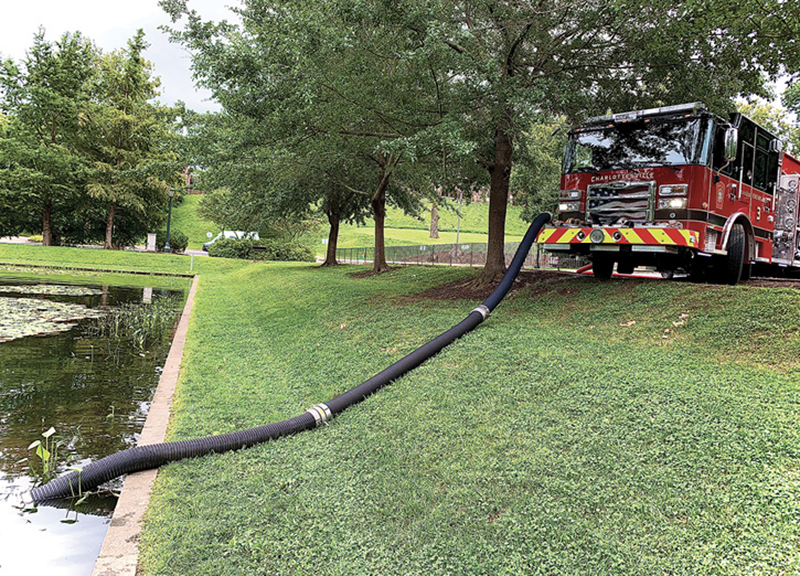
2 One option for reaching distant water sources is to perform “the long reach” using multiple sections of hard suction hose.
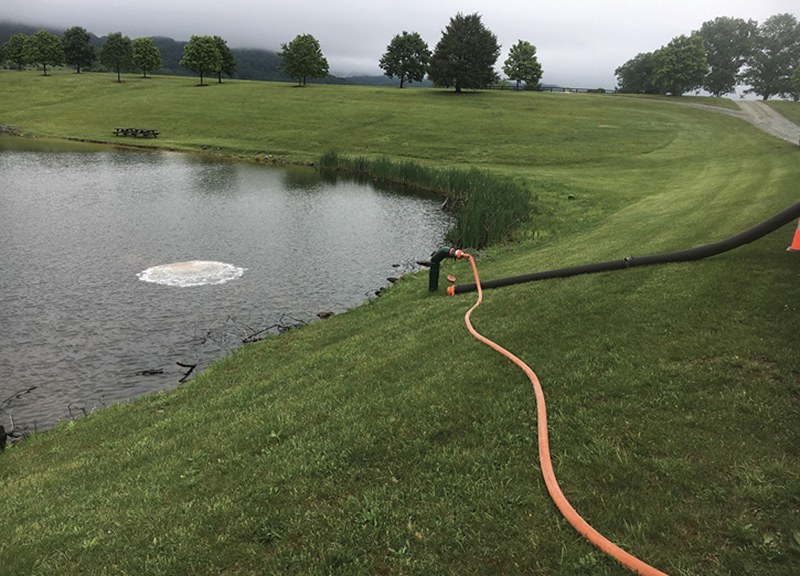
3 When using a dry hydrant to access distant water sources, it is critically important for the operator to flush the hydrant prior to attempting to draft.
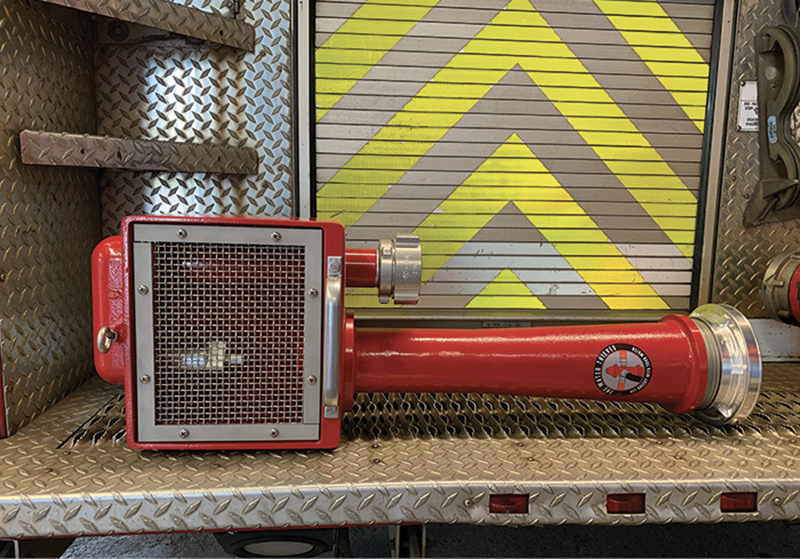
4 The TurboDraft Fire Eductor is equipped with a 2½-inch inlet that supplies the nozzle located within the basket strainer housing. This nozzle is pointed toward the volute, where a 5-inch return hose is connected that supplies the pumper with water.
The TurboDraft Fire Eductor is one option for overcoming access issues in the rural environment. If you operate as part of a short-staffed, rural engine company that consistently must overcome long setbacks to reach your water, then the TurboDraft is the answer to your rural water access problems (photo 1).
Traditional Solutions to Access Issues
Before we dive into the operation of the TurboDraft, let us first briefly discuss some potential solutions to access issues that your department may already be using. Some of these options may include “the long reach,” dry hydrants, and portable pumps. These options are valid ways of overcoming access issues in the rural environment; however, each has disadvantages.
Long reach. This refers to using multiple sections of hard sleeve to reach the objective. Here, the water source is beyond what 20 feet of hard sleeve will reach; 20 feet is used as our reference point here because National Fire Protection Association (NFPA) 1901, Standard for Automotive Fire Apparatus, states that pumpers must carry a minimum of either 20 feet of hard suction hose or 15 feet of supply hose.1 In my experience, this usually means that a single engine is only carrying 20 feet of hard sleeve unless the department specifies a different amount carried.
In a long reach operation, we are simply connecting the necessary amount of hard sleeve together until we reach the water source (photo 2). While this operation will usually result in a decent flow/fill rate, it does have several disadvantages. First is the amount of time it takes to acquire all the necessary hard sleeve, especially if each rig is only carrying two 10-foot sections. Second is that there are multiple failure points within the operation—for example, each hard sleeve connection, because they can allow air to enter the system when firefighters forget to check for gaskets or when the connections are not tightened using a mallet.
This is a critical skill that firefighters must understand. I was once part of a training exercise where students were tasked with establishing a long reach operation where the water source was 100 feet from the engine. It took students 45 minutes to establish their prime—all because they did not appropriately tighten their connections.
Dry hydrants. They are also an option for overcoming access issues in the rural environment; however, they, too, bring their own set of challenges. Depending on the climate and time of year, the source equipped with a dry hydrant may be susceptible to droughts that lower the water level below the depth of the dry hydrant strainer. This effectively marks the dry hydrant out of service. In addition, dry hydrant strainers are susceptible to clogging, especially in sources with a lot of vegetation (photo 3). Finally, they can become damaged fairly easily, since most dry hydrants are made of PVC pipe. Any damage to the dry hydrant may allow air to enter the system and cause difficulty achieving or maintaining a prime.
Portable pumps. These units can move respectable volumes of water, but they tend to be rather cumbersome to move around in rural environments—requiring at least two firefighters to carry. As mentioned earlier, staffing is usually an issue in the rural setting, and there may not always be a second set of hands to help move this piece of equipment. Don’t forget that portable pumps require a full tank of fuel and a working battery to operate. If you rely on these units, operate them routinely to ensure they work when you need them.
The TurboDraft
The TurboDraft Fire Eductor is manufactured by Schutte & Koerting. The original design for the TurboDraft stemmed from units the company manufactured for the U.S Navy for shipboard firefighting and dewatering operations.2 This design was later adapted for use by the modern fire service—the TurboDraft Fire Eductor.
The TurboDraft has four major components that enable it to operate: the basket strainer, the inlet, the nozzle, and the volute (photo 4). These four components come together to allow this device to move water using the Venturi principle—basically, the device is a jet siphon on steroids. The TurboDraft requires water to be pumped at a high pressure through the device’s nozzle to create the Venturi effect that delivers a higher return flow rate. The water used to “power” the process is known as the “motive.” When pumped appropriately, the motive to power the device is 200 gallons per minute (gpm).

5 To work effectively, no more than 100 feet of 5-inch hose should be used with the TurboDraft. This will yield the desired water flow return ratio to make this device effective in the rural environment.
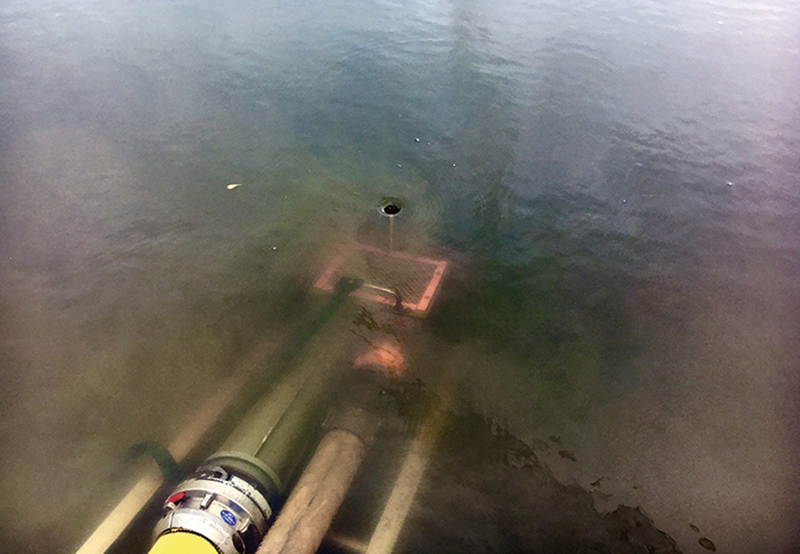
6 The TurboDraft pictured here was secured to a ground ladder and then pushed into the source. Since this source had a shallow bank, it caused the ladder to dig into the bank and limited how deep the TurboDraft was submerged. This caused a whirlpool to form during the operation, which limited flow.
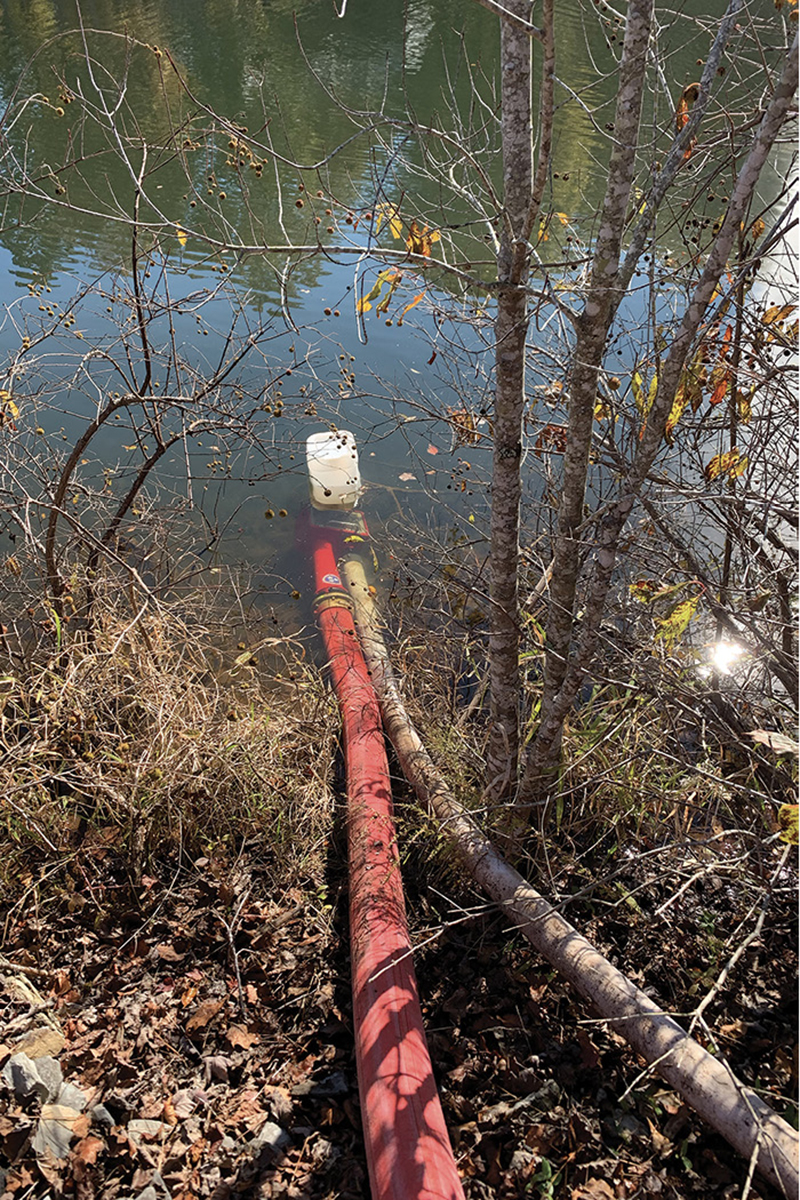
7 The easiest way to deploy the device is to attach some sort of float to the eyelet on the device and toss it into the water.
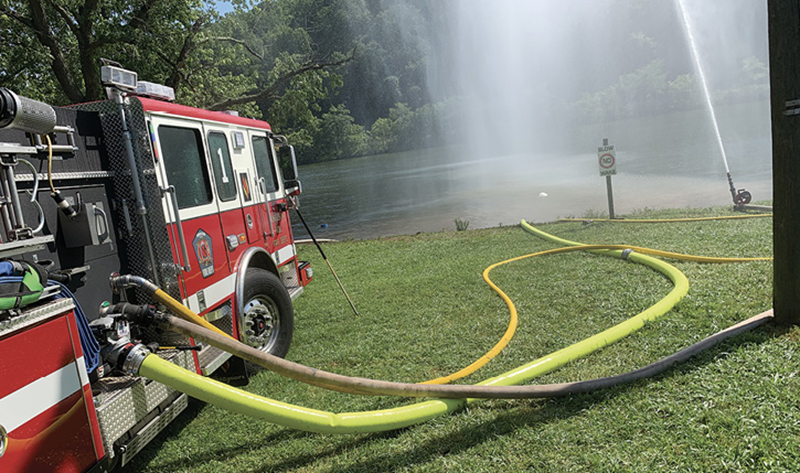
8 Once the discharge feeding the TurboDraft is opened, the operator will almost immediately notice water returning toward the pumper through the 5-inch supply line.
In its conventional configuration, the TurboDraft uses soft hose to operate. This is what allows the TurboDraft to be deployed so rapidly and with minimal staffing. When connecting to the inlet side of the device, the operator must use either 2½- or 3-inch hose. On the discharge side of the device, the operator must use 5-inch hose or large; anything smaller will result in a diminished water flow return that essentially renders the device useless.
Conventional TurboDraft Operations
First, carry the device to the water’s edge and lay out the necessary hoselines for the operation. The length of the 5-inch supply line between the pumper and the device has a direct effect on the amount of water that will be delivered during the operation. The general rule of thumb for TurboDraft operations is that the maximum amount of 5-inch hose that should be used is 100 feet (photo 5). (The manufacturer says the maximum is 250 feet.) This results in roughly a 2½:1 water flow return ratio. The longer the 5-inch line, the smaller the return ratio; the shorter the 5-inch line, the larger the return ratio.
Generally speaking, 100 feet of 5-inch supply line from the device will yield a 550-gpm usable flow rate from the device. This does not include the 200-gpm motive used to power the device. When the 5-inch supply line length is shortened to 50 feet, a 650- to 700-gpm usable return rate can be expected (again, not including the motive).
Next, the operator must make the appropriate connections: Connect the 2½- or 3-inch hose from a discharge on the pumper to the inlet of the TurboDraft. In the conventional configuration, then connect one end of the 5-inch supply line to the discharge side of the TurboDraft (the volute) and connect the other end to an intake on the pumper equipped with a valve.
Now the device is ready to be placed into the water source. Under most circumstances, it is never advisable to place the device directly in the water without ensuring that the strainer will face upward. The TurboDraft produces a very powerful Venturi that causes anything in the surrounding vicinity to be drawn toward the device, including silt and debris. If the TurboDraft is allowed to flip upside down and face the bottom of the source, the operator runs the risk of clogging the pump with silt and debris.
One option for placing the device into the water source is to tie the unit to a ground ladder. The operator is then able to slide the unit into the source using the ground ladder. This option is ideal when operating in a moving body of water because you can anchor one end of the ladder to keep the current from flipping the device upside down. If the source is a static body of water with a shallow bank, avoid using this option because the ladder tends to dig into the bank and prevents the TurboDraft from getting deep enough into the source (photo 6).
For most sources, the easiest way to get the TurboDraft into the water is to simply attach a float to the anchor point on the device, then toss or push it into the water (photo 7). Some of the best and most reliable floats I have used are empty foam pails. The weight of the device plus the buoyancy of the foam pail allows the device to sink deep enough below the water’s surface yet still float to avoid whirlpooling.
Now the operator can begin the process of establishing a water supply. Starting the conventional TurboDraft operation requires the pump operator to use a portion of the booster tank water. This means the engine must have water in its booster tank for the operation to work. If there is no water in the booster tank—or the operator runs out of water attempting to establish the operation—there is no possibility of establishing a sustainable supply.
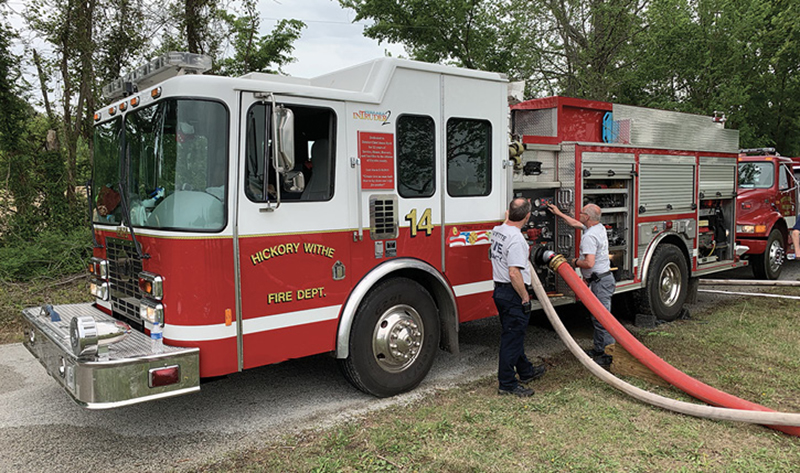
9 The operator must be mindful to maintain at least 200 psi on the discharge gauge supplying the device.

10 The TurboDraft reaches its peak flow capability once the supply line begins to get soft enough to “squeeze.” It is imperative that the operator maintain a hand on the 5-inch supply line to gauge the remaining flow capability of the device.
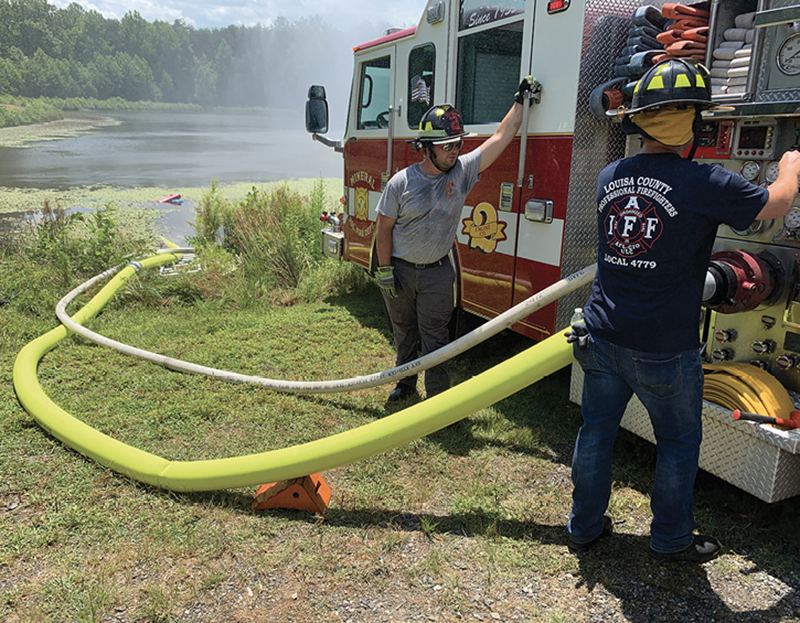
11 The minimum size return line that should be used during conventional TurboDraft operations is 5-inch hose.

12 Kinks absolutely kill the return flow rate provided by the TurboDraft. In this photo, a backboard is used to remove the kink originally formed by the supply hose being laid over the corner of a bridge.
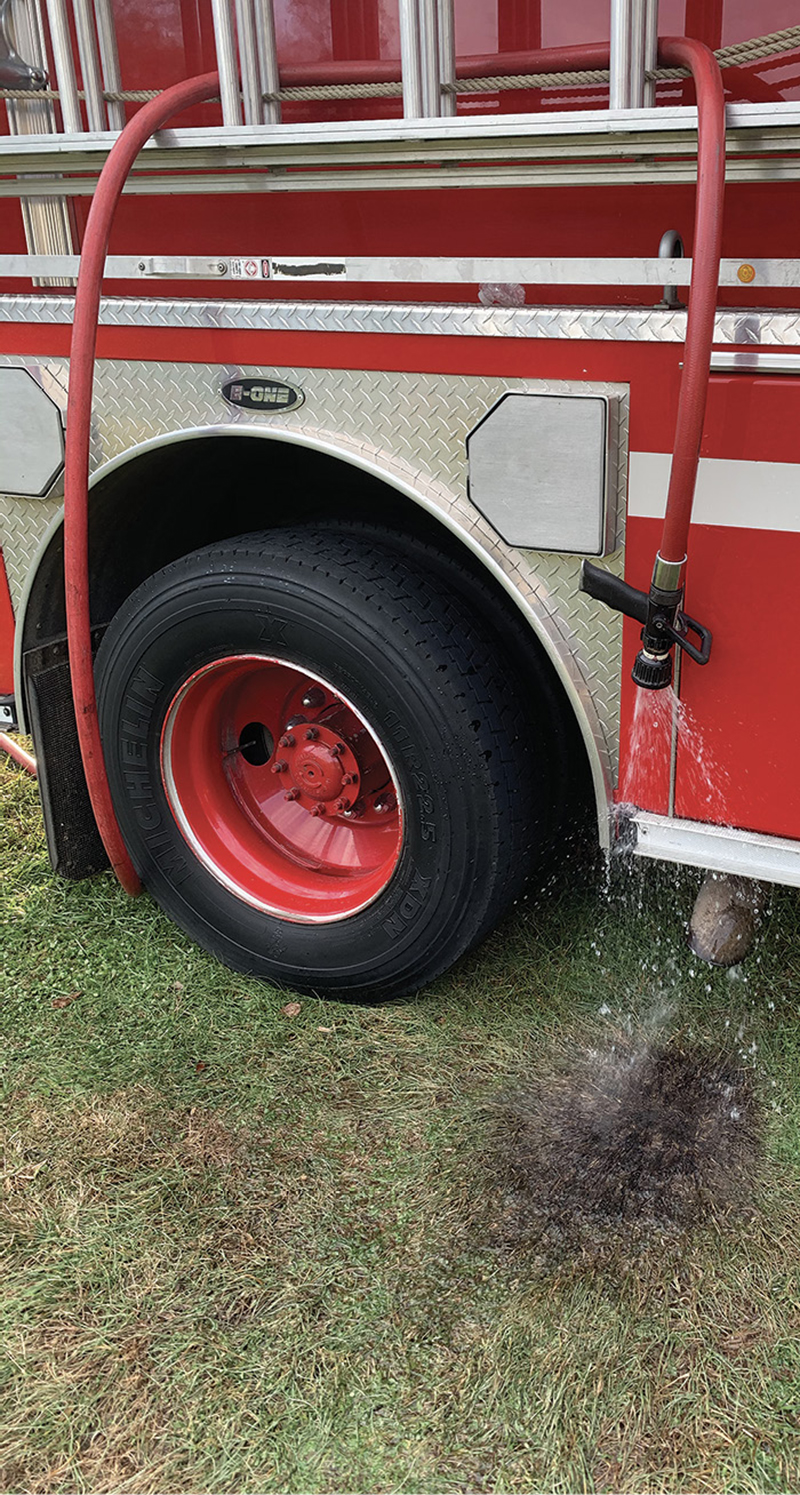
13 Be mindful of the heat generated by the high engine rpm during a TurboDraft operation and take the necessary steps to establish an exposure line.
With the pump engaged, the operator will first open the tank-to-pump line. The operator will then open the corresponding discharge feeding the device. It is critically important to remember that once the line feeding the TurboDraft is charged, the operator has a definitive amount of time to establish the supply before running out of tank water. In most cases, it should only take a couple hundred gallons of tank water to establish the process.
Once the discharge line is opened, the operator should immediately begin throttling up to 200 pounds per square inch (psi) on the individual line discharge gauge. As stated earlier, for this process to work, the water being pumped into the TurboDraft must be pumped at a high pressure to create the necessary Venturi effect. The owner’s manual for the device states that the line feeding the TurboDraft should be pumped between 175 and 225 psi.2 Since the TurboDraft is basically a giant foam eductor—and most foam eductors are designed to be pumped at 200 psi at the eductor inlet—I always begin at 200 psi for my TurboDraft operations. Another way to remember it is the following: 200 psi at the discharge equals 200-gpm motive at the device.
Once the discharge is opened and at the appropriate pressure, the operator will almost immediately notice water returning up the 5-inch supply line (photo 8). The next most critically important step in the operation is to eliminate the air trapped within the supply line. The operator should open the intake bleeder and leave it open until a solid stream of water emerges out of the bleeder. The operator can then close the bleeder valve and slowly open the intake valve. Water is now entering the pump from the outside source.
After completely opening the intake valve, the operator should close the tank-to-pump valve. Next, the operator should begin refilling the booster tank. It is critically important to ensure that the booster tank is full at all times during a TurboDraft operation because if the supply line collapses, the operator’s first troubleshooting step is to reopen the tank-to-pump line. This will effectively “jump start” the operation and allow the operator to regain the supply.
With the tank-to-pump closed and the booster tank topped off, the operator is now ready to begin discharging water either to the fire scene or to fill tankers. The operator must remember to slowly open the discharge valves and always maintain at least 200 psi on the one discharge supplying the TurboDraft (photo 9). For rigs with manual throttles and discharge relief valves, this will involve slowly opening the second discharge while simultaneously increasing the throttle to maintain 200 psi on the original TurboDraft discharge. For rigs equipped with pressure governors, this is the advantage of operating in the psi mode. The discharge supplying the TurboDraft must remain fully open for the entire operation; otherwise, the process ceases. All other discharges supplying water either to the fire scene or to fill tankers will have to be gated.
TurboDraft operations are very much a game of feel; the operator should constantly be feeling the firmness of the 5-inch supply line (photo 10). As the operator increases the flow rate, the supply line will gradually get more and more limp. If the supply line gets too soft, it may collapse in on itself and the process will cease. This is where the quick-thinking operator will reopen the tank-to-pump line to “jump start” the operation and gradually gate back the discharge flow rate. Once water returns from the TurboDraft, the operator can shut down the tank-to-pump line.
This is again why it is so critical to maintain at least 200 psi on the discharge line feeding the device. If the discharge pressure drops on the line feeding the TurboDraft, the water being discharged out of the TurboDraft nozzle moves slower and slower. The slower the water moves out of the device nozzle, the less of a Venturi is created, and therefore less water is directed up the volute and through the 5-inch supply line. This, in turn, results in a softer 5-inch supply line that is more prone to collapsing.
Key Points to Remember
- Always ensure that your booster tank is full. This process initially begins by using a portion of the onboard tank water. If the booster tank is empty, this process will never get started. If you run out of tank water before opening your intake, the process will not be completed. Failure to refill your tank after establishing the operation leaves no way to jump start the operation if the supply line collapses.
- You must use at least 5-inch or large supply hose as the return line. Using hose that is smaller than 5 inches in diameter on the return side of the eductor will result in diminished return flow ratios that render the operation futile (photo 11).
- Do not exceed 100 feet of 5-inch hose in the conventional setup. The shorter the run of 5-inch hose, the better the return ratio. For 100 feet of 5-inch hose, expect a usable flow rate of about 550 gpm. For 50 feet of 5-inch hose, expect a usable flow rate of 650 to 700 gpm.
- Kinks kill TurboDraft. Remove any kinks that may be present (photo 12). Kinks in the 5-inch hose will reduce the return flow rate coming from the eductor. This is another reason to only use the amount of 5-inch hose necessary to reach the source; do not use a 100-foot section when you only need 75 feet of hose. The extra 25 feet of hose will inevitably result in kinks in the line.
- Pump at least 200 psi to the eductor. Failure to pump at the appropriate pressure feeding the eductor will result in a low return flow ratio and will increase the probability of the supply line collapsing.
- TurboDraft operations require high engine revolutions per minute (rpm) and result in loud work areas. To maintain 200 psi on the eductor discharge and flow the other lines off the pumper, the apparatus will be operating at a high engine rpm. This is normal during TurboDraft operations. Be mindful of the areas surrounding the exhaust pipe because the temperature of the exhaust gases will be high enough to melt asphalt or catch grass on fire. Set up the appropriate exposure lines as necessary (photo 13).
- Make sure the strainer is facing upward. Failure to do so may result in silt and debris clogging the TurboDraft strainer or even the pump intake strainers.
. . .
Accessing rural water sources is one of the biggest challenges that rural pump operators are forced to overcome. While many options exist, the TurboDraft Fire Eductor offers short-staffed companies a way of quickly and efficiently accessing their water. A pump operator properly trained in the use of a TurboDraft can be expected to deploy the necessary hoses and make the appropriate connections, place the device into the water source, and achieve a water supply up to 100 feet away within approximately 10 minutes.
In Part 2, we will examine alternative methods for using the TurboDraft that will yield higher flow rates and allow us access to water sources that are beyond 100 feet from the pumper.
Endnotes
1. NFPA 1901, Standard for Automotive Fire Apparatus, 2016. National Fire Protection Association, 2016.
2. “TurboDraft Fire Educator Operating Instructions.” 2510 Metropolitan Drive, Trevose, PA 19053, 2000.
ANDY SOCCODATO has served in the fire service for the past 15 years. He spent nine years as a firefighter and driver/operator for the Charlottesville (VA) Fire Department. He is a full-time Fire Instructor II at the Tennessee State Fire Academy, where he oversees the driver/pump and aerial programs. He is the owner of The Water Thieves, LLC, which specializes in delivering street-smart driver/pump operator courses.

